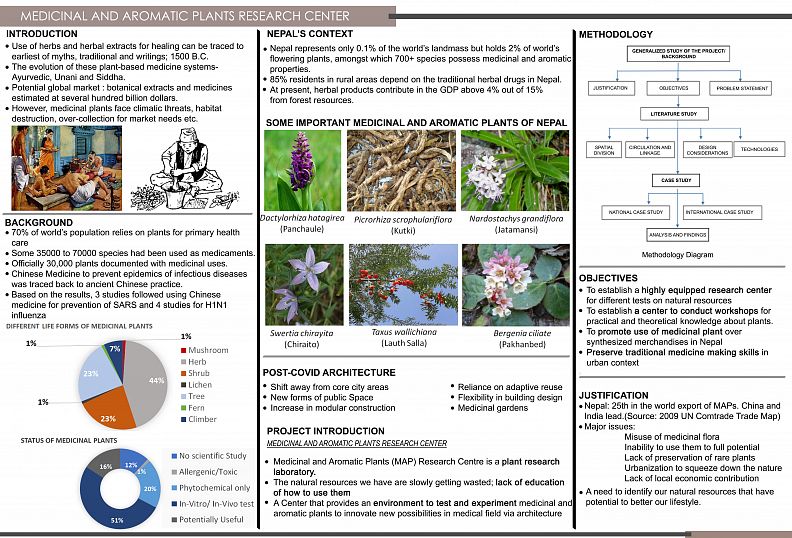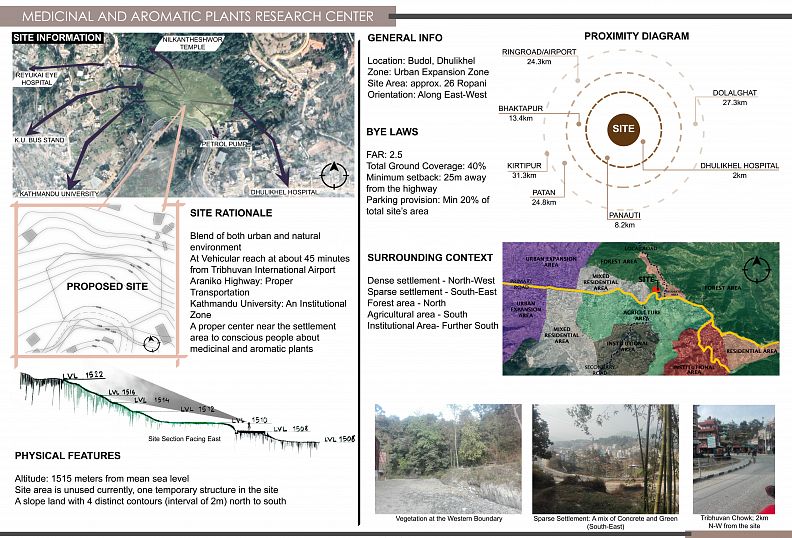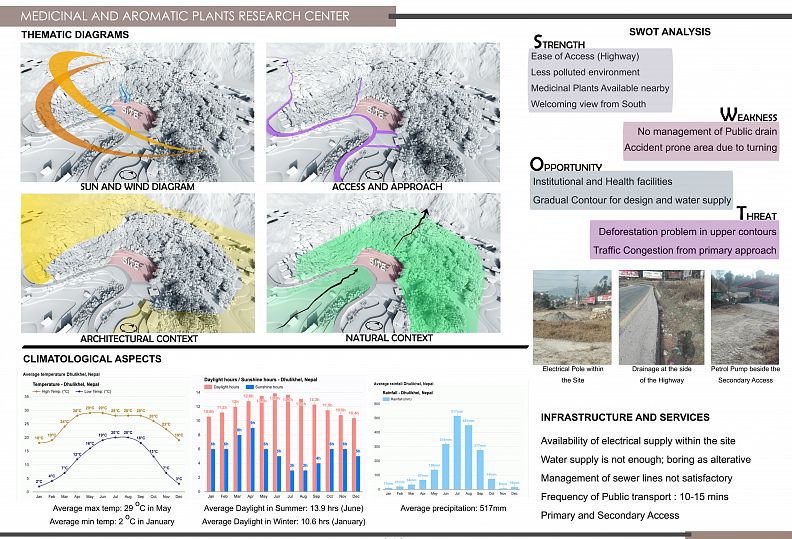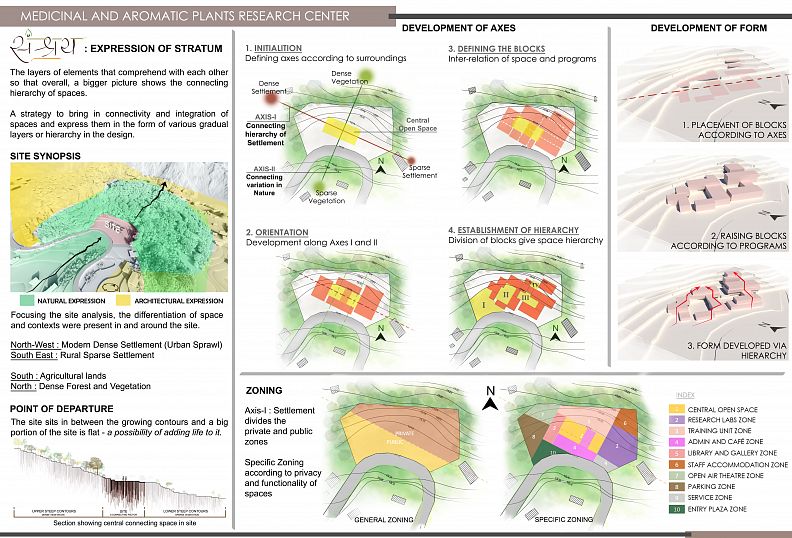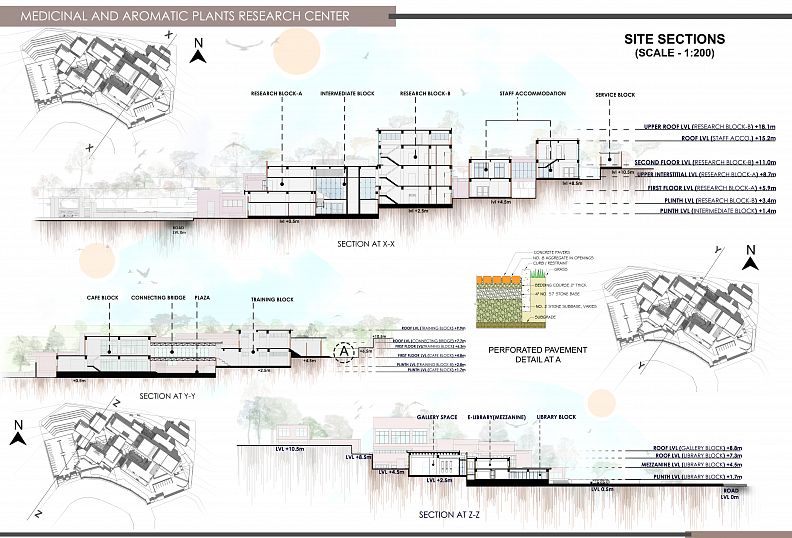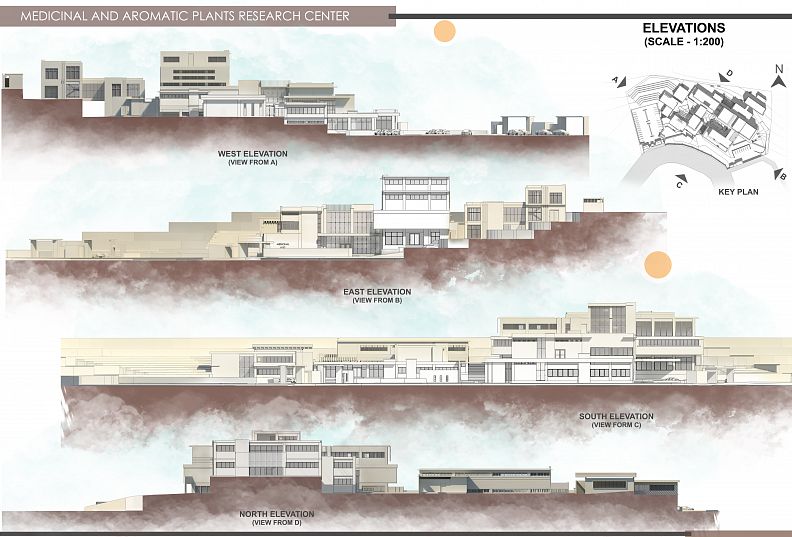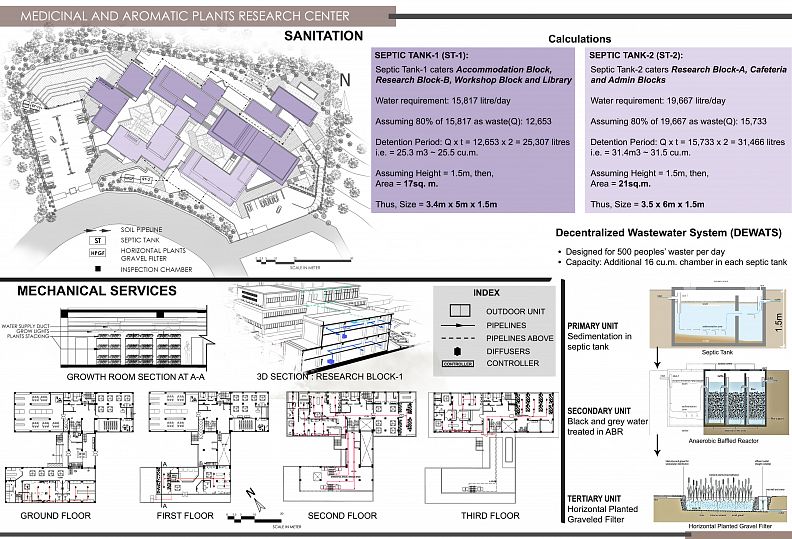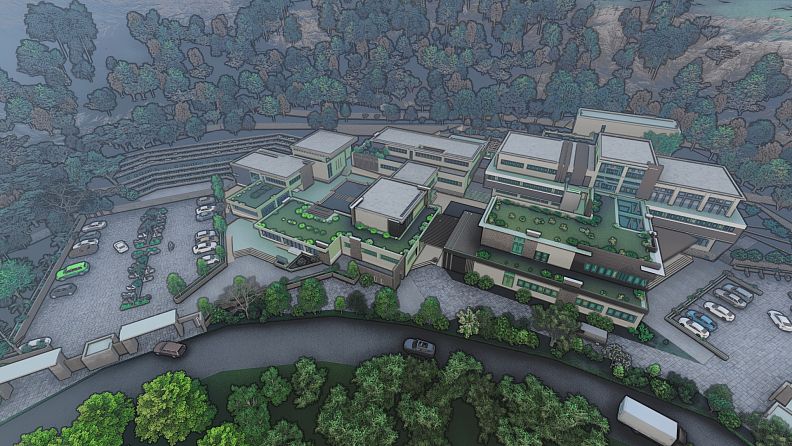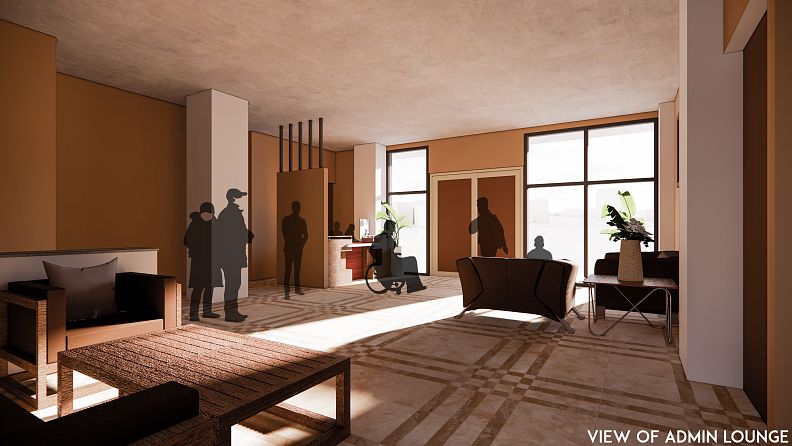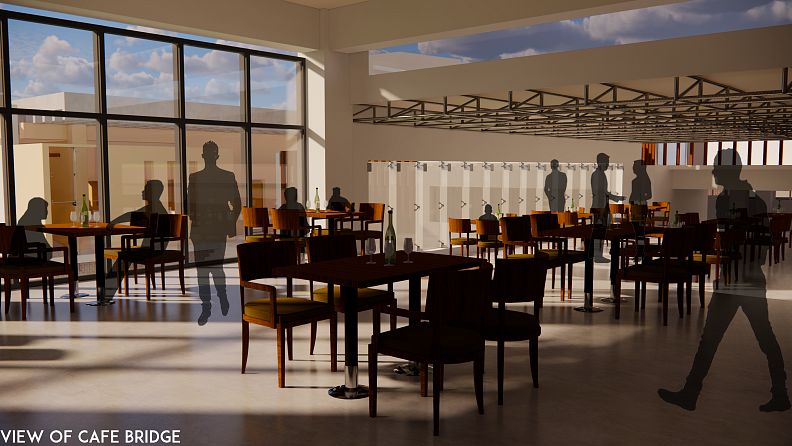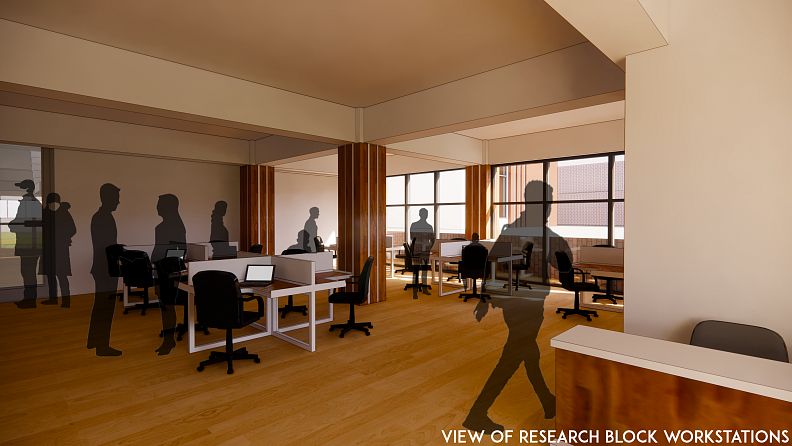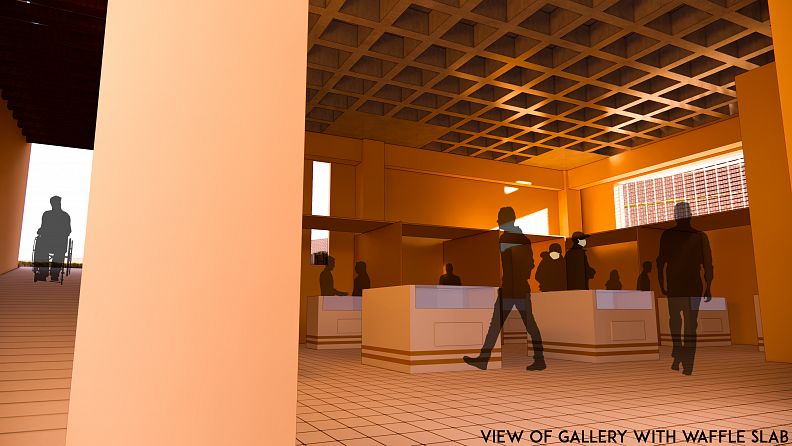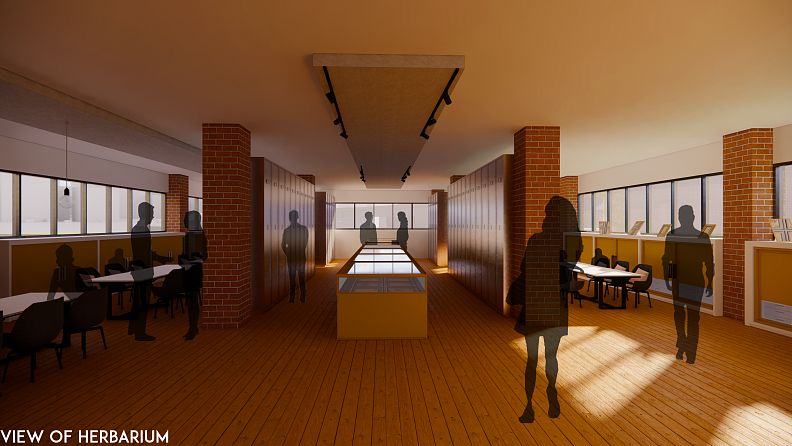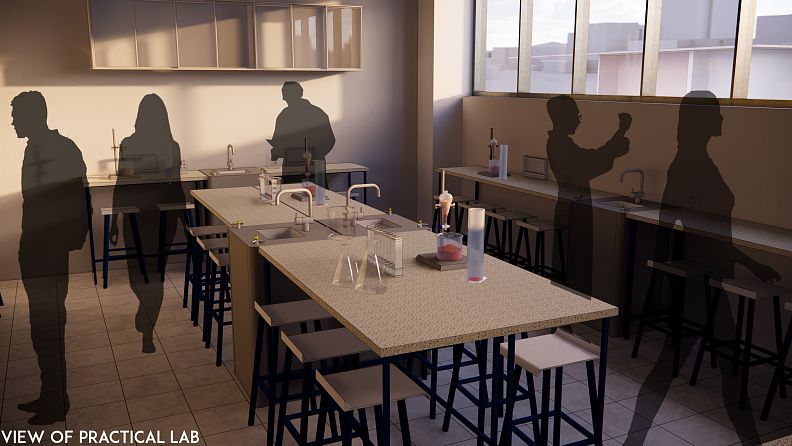Samsraya- Medicinal and Aromatic Plants Research Center

Idea projektu
Tying up the results of the done case studies, literature reviews along with the properly done site analysis gave the necessary information and a backbone in order to continue this project further to design phase. With site analysis being one of the major aspects for the development of conceptual design, the design was tried best to be brought out from the site itself. Since the project largely deals with plants and vegetations, so it was important to keep the site aspects intact because of the vegetations around the site. The research conducted regarding various availability of plants gave a platform to develop various corners of the site with all those medicinal plants abundantly available around the site area.
The design attempt was to add the architectural input in the site while preserving the natural essence of site. Based on the site analysis, history of site and existing surroundings, the vision was to create a space that connects people with different activities as well as to enhance the researching environment needed for the students and researchers. Architecturally speaking, various provision of universal design, wastewater management, rain water harvest and green design approach has enriched the design.
The attempt was also to create a sustainable approach to design such that the project enhances the space of the chosen site and thus help create a better environment for all. The use of passive sustainable approach which is well integrated into the design would lead to minimum impact to the site. In addition to that the design minimizes the use of artificial energy for lighting and ventilation. Those spaces that required mechanical ventilation have been dealt in such a way that it marks the least impact to the environment.
Ultimately, the goal of the project was to provide a proper platform for the researchers and students which will guide them and help uplift the overall researching scenario of Nepal. Also, this center provides the indigenous knowledge associated with the traditional use of healing herbs which can then directly help the local people in production and further research practices in the valley. Since the global pandemic brought a significant change in the lifestyle of people, it seems fair to follow the idea that the traditional medicinal and aromatic plants need to be researched properly because it can well be the cure to such life-threatening disease.
To sum it all, Medicinal and Aromatic Plants Research Center is a project that will not only connect the medical field with architecture but also provide the users a unique space that might make them sense how nature and concrete can go hand in hand. It is aimed to provide a space where researchers not only conduct their works but rather communicate, interact and exchange ideas regarding the subject, making it a more vibrant yet a disciplined space to work on. It might help the users know the fact that between nature and artificiality, there is a search for an attitude that corresponds to the condition of the surrounding.
Today, it is time for us to adjust to what we have and at the same time return to the initial point of our origin. It is time to make use of something that had been there forever and respect the offerings of mother nature, just like how architect Antoni Gaudi quoted, “Nothing is invented, for it is written in the nature first, originality consists of returning to the origin.”
Popis projektu
Design Development
CONCEPT: Expression of Stratum
The central factor in experiencing our environment are connectivity and integration. Humans usually allure themselves to any contrasting ornamentation or the continuity and connectivity of any design. The Stratum here refers to the layers of elements that connect with each other so that overall, a bigger picture shows the connecting hierarchy of spaces. The concept revolves around the strategy to bring in connectivity and integration of spaces and express them in the form of various gradual layers or hierarchy in the design. Here, the concept is seen in the form and planning of the project along with some materials to guide the design justification as well.
1. Site Synopsis:
The concept strongly derives itself from the surrounding and context in which the site is located. Taking site analysis into sheer focus, we could see how the differentiation of space and contexts were present in and around the site. The architectural configuration of Budol (Dhulikhel) area consisted of rapid urban sprawl towards the tilted west where the population seemed to get denser as it spread from the Kathmandu Valley. With various modern structures as we proceed from Banepa area, the north-western region comprises of developing and growing scenario therein.
However, a drastic change is seen at the exact opposite direction, the south-east region of the site. At this end, the rural essence of the Kavre district are reflected as the structures and scenarios are old, traditional and rustic. The undisturbed nature can be seen merging with the houses placed there. The sparse settlements depict as if the urban sprawl is yet to take over the eastern region.
2. Conceptual Development:
Looking at the southern and northern portion of the site, it is not just about the concentration of architectural expression but also the natural expression. The variation is seen also in natural elements along with building structures. Seen from the section above, we can make out the manner in which the terrains and vegetations behave. The portions both above and below the site (north and south respectively), consist of steep contours ascending from south to north, the reason why any structures are barely made there. The site sits in between the growing contours and fortunately, a big portion of the site is flat due to which there is possibility of adding life to it. It can be seen how the northern portion consists mostly of dense vegetation and southern portion consists of sparse vegetation. These areas lack the space for communication and socialization due to vegetation and agricultural lands.
3. Design Approach:
The major objective of the concept here is to express the differences around the site and connect them from the project. Since the east- west portions vary immensely regarding architectural context and the north- south portions vary in natural context, the site I chose plays a key role in connecting the discontinued and bring forth the hierarchy of spaces as design progressed.
Thus, keeping these aspects into consideration, the point of departure is drawn out where a central communicating space is developed and draws more people in the research center. The central space/s cater public interaction and are surrounded by various building blocks, making it behave like a courtyard.
The design is aimed to adapt as the connecting factor of the discontinuing surrounding, bringing a sense of gradual change and hierarchy in built structures as well as open spaces. Hence, the design approach labeled – An approach to connect the architectural differentiation via hierarchy of space.
4. Development of Axes:
a. Two major axes are defined according to the site analysis and the nature of the site:
• Axis -I: This axis connects the discontinuing hierarchy of settlements from north-west to south-east. This axis denotes the connectivity of people, such that a central space developed in the site acts as a public interaction space.
• Axis -II: This axis connects the discontinuing variation of nature and vegetation from north-east to south-west. Since it intersects with the axis-I, the intersection now creates a space where nature is celebrated along with life.
b. Orientation:
The orientation of the central space now tilts along the two axes and thus the built forms developed around the central space also gets tilted accordingly. This then divides the central space to two major spaces.
From the building science point of view, the tilt gives maximum exposure to daylight from the south as well.
c. Defining the Blocks:
The programs guide the positioning and the size of the blocks and the interrelation of spaces are established consequently. Those spaces which required shared programs and those that required particular programs are adjusted and blocks now get more specific/developed.
d. Establishment of hierarchy:
As the blocks now get specifically divided, the spaces become clearer and the alternation of open and built spaces are maintained such that there is the provision of space hierarchy. Due to such space hierarchy, the major aim of the concept, which is to guide the user from an infinite scale to human scale which gradually adjusts the psychology of the user visiting the center. A series of courtyards helps to guide users to various spaces of surprise, just like our traditional courtyards.
5. Form development and Zoning:
The form development also follows the principle of hierarchy as the blocks tend to ascend along with the contours. With the programs taken into consideration, the blocks take up a volume according to their position along the axes. The bulk of the volume are then divided such that a simple hierarchy is maintained, ascending from south to north, just like the site context itself.
The zoning has been done in two major steps; general zoning and specific zoning. The general zoning initially divides the site from the axis-I. The private and public zones are divided, taking all the aspects around the site into consideration.
Specific zoning then comes into play when the areas get divided surrounding the central courtyards. The zones directly connected to the primary road are more public zones, mainly parking, admin, library, café and gallery spaces. On the other hand, the spaces connected to secondary access bring out comparatively private space; research blocks, workshop block and staff accommodation in particular.
6. Identity:
The developed masterplan is a product of various references from case studies, analyses and site study. In addition, conceptual visualizations were altered several times to attain the amalgamation of both traditional as well as modern outlook in the masterplan. Taking design inspiration from modernism style of building design, simple blocks were positioned with various connections and penetrations. Associated with an analytical approach to the function of buildings, a strictly rational use of (often-new) materials, an openness to structural innovation and the elimination of ornament, the characters of modernism are made to reflect in every way possible.
The planning of built and open spaces is done as per the site zoning, user requirements and access to the site. With the specified zoning developed further, the masterplan retains the essence of narrow alleys that lead towards the open courtyards that function as main communal space.
The developed masterplan consists of various accesses and approaches within the site as shown in the picture above. The routes merge within the landscapes such that proper movement is obtained and thus the circulation in and out of the site could be easily justified. The circulation includes access routes for visitors, researcher and general staffs along with service routes, emergency circulation spaces and universal access at various positions in the site.
7. General Planning:
The site consists of two entrances, one from the western portion; primary road, for the public and the other from the eastern portion; secondary road, for the private researchers. From the public entrance, it gets the user up to the parking space and then towards the raised plinth that consists of administrative block upfront. Just beside it, towards the western region, is the reference library that caters the users for them to acquire any knowledge related to medicinal and aromatic plants. The central courtyard consists of greenery itself and the courtyard is surrounded by gallery block at its north-west, workshop block at the north and a connection of workshop block with the café situated at the eastern portion of the public courtyard. The café just separates the courtyards into public and semi-public courtyards.
The connecting bridge from the cafeteria creates a sense of privacy at the second courtyard that is surrounded by the research block wholly from three sides. The research block can be accessed from the private parking space at the east as well. The researchers can access the block at various levels as their specific user preference. At the upper contours, towards the east, the service lane consists of a ramp that guides the service vehicle directly to staff accommodation block. The service road goes towards the storeroom of the workshop block and ends at the gallery space. This road has been developed according to the frequency of usage of materials/goods in various blocks.
The north-western portion of the site consists of a medicinal garden that acts as the breakout space from the gallery as well. Similarly, northern portion consists of another natural entity, the learners’ plantation space for workshop users to plant their own medicinal and aromatic plants. Finally, the topmost contour consists of water services block at the east. The northern portion of the site consists of forest area that continues towards the site as well.
8. Architectural Expression:
The overall design of the research center is in Modern form. The ample use of glazing, concrete panels, wooden panels and louvers contributes in achieving functional and modern look to the complex. The courtyards and the interconnecting green strips are the elements to make the building breathe. In case of interior spaces done by double height rooms and mezzanine floors. The landscape is developed with respect to the sides of the site.
Inspired by the design of The Falling Water by master architect Frank Lloyd Wright, it helps to justify that as the building emerges from the site, it can still complement natural elements in the site even with rigid lines and does not necessarily have to be fluidic lines in the built form.
9. Basic COVID Analysis:
One of the highlights of 21st century today remains the existence of COVID-19. With the whole world pushed back to lockdown, it has taught us that architecture should actually respond to such pandemic from as many angles as possible. As an architect, we try our best to establish a building that is specific to its purpose. However, the pandemic has taught us that in such emergency scenarios, there must be a provision to convert any given building into temporary quarantine spaces.
Since this project, Medicinal and Aromatic Plants Research Center, is closely related to the field of medicines, it would be wise enough to think about at least one major portion of the complex to be analyzed well enough for COVID emergencies. Thus, the research block itself has been designed keeping in mind about the possibilities of the building to be converted into a temporary quarantine zone. The research block consists of labs spaces that need to be sanitized and sterilized thoroughly. This was the plus point for the COVID analysis because it is exactly the type of cleanliness needed while patients are in quarantine.
General zoning has been drawn out for converting the block into a quarantine zone with labs and growth rooms being converted for potential quarantine chambers and the common lobby spaces being kept for taking up patients and providing space for authorized visitors. Entering chamber remains the same as it becomes one vital part during this alternate zoning. The partition walls in labs are mobile and thus one whole hall can be occupied for quarantined patients if needed.
Technické informace
1.Structure:
Size of beams for each block are shown below:
Research Block = 450mm x 630mm
Admin Block = 350mm x 530mm
Workshop Block = 450mm x 670mm
Café Block = 450mm x 670mm
Staff Accommodation Block = 350mm x 530mm
Library Block = 450mm x 670mm
Gallery Block = 200mm x 500mm waffle slab with 700mm waffle slab void
The research block is a huge three-storey block altogether that consists of column of size 600mm x 600mm. Due to its large overall span of the building and due to irregular linear shape, isolation joint was seemed to be necessary at two points. The long linear building block are separated from one another by providing isolation joint of 50mm so that the building acts separately during earthquake.
The café block is a double storey framed structure with the column size 600mm x 600mm. It is a composite of RCC structure as well as steel structure.This block has one of the main components; a connecting bridge. The bridge is supported by pratt truss made of channel sections whose overall span is 13.4m.
2. Water Supply:
Total amount of water required / day: 24,472 litres/day
Firefighting: 25% of total demand = 25% of 24,472 = 6,118 litres
Extra storage: 20% of 24,472 = 4,894 litres
Total demand: 24,472 + 6,118 + 4,894
= 35,484 litres/day ~ 35,500 litres
= 35.5m3/ day
For size of water tank,
Take, Height of Water Tank (h)= 2 m
L x b x h = 35.5
L x b = 35.5/2 = 17.75
Therefore, size of water tank = 3.6m x 2.5m x 2m = 18 m3 tank to be filled twice a day.
3. Sustainable Approach:
a. Building Orientation: The building form is placed along the tilted east-west axis where the facades and openings are planned facing towards the south such that maximum sun exposure is available into the building. Two major courtyards with medicinal vegetations create a sense of coolness and freshness among people. The blocks ascent from south to north such that every block gets proper sunlight as required.
In research block, the orientation of the block helped well for the position of Phytochemistry lab with FTiR is necessarily kept in the northern face to avoid any daylight possible because of the functional demand of the space.
b. Roof Garden: Roof gardening provides temperature control, hydrological benefits, architectural enhancement, habitats or corridors for recreational opportunities. Plants have the ability to reduce the overall heat absorption of the building which then reduces energy consumption. Species of grasses, alliums, herbs and wildflowers can thrive in 10 cm of growing medium. One of the most important components of the green roof system is the waterproofing/roof membrane. Typical wet soil weighs approximately 1,597 kg per cubic meter.
c. Light and Ventilation: Buildings are planned such that maximum lighting and ventilation go in and out through the blocks. The major focus is given towards the research block where toxic fumes need to be well ventilated. Along with mechanical ventilations, there are various design strategies that allow natural ventilation to circulate in and out of the buildings. The interstitial space plays an important role in natural ventilation in labs. These spaces have open louvres due to which ventilation outlets bring out filtered air to the environment, causing considerably less pollution as well as thorough circulation of air.
One of the most prominent examples of lighting and ventilation in research blocks is the planning of labs themselves. The labs that are not bothered by sunlight are positioned at the southern face of the building whereas labs like Phytochemistry lab (where spectroscopy for plants are done), dark rooms, chemical storage that do not require exposure from the sun, etc. are all kept strategically keeping in mind about the artificial lighting as required and mechanical ventilations in such spaces.
4. Materials:
a. AshCrete is a substitute for traditional concrete that relies on the use of fly ash. Composed of about 97% recycled materials, this alternative is made from fly ash, borate, bottom ash, and a certain chemical from the chlorine family. Fly ash known as pulverized ash is to be used instead of cement in concrete. Fly ash is a waste product which require proper disposal so to ensure environment preservation besides increasing the durability of concrete, fly ash can be adopted. For construction purposes, ashcrete is known for its remarkable strength, having roughly twice the strength of Portland cement. The most notable advantage one gets from using ashcrete is the reduced permeability to aggressive chemicals and water (which is important in labs). Since the product is properly cured, one can expect ashcrete to have smaller pores, resulting in better strength and permeability.
b. High Density Polyethylene (HDPE) is a thermoplastic polymer produced from the monomer ethylene. It is best known for its high strength-to-density ratio. This material can withstand higher temperature of about 120 degrees.
The labs in research block are all made of HDPE material of 0.5 inches to 2inches thick and are mobile as well, i.e. users can temporarily take off the partitions if labs are to be functioning as a single unit. Since these materials are 100% recyclable, thus it can be considered environment-friendly as well. Similarly, it requires low maintenance and can withstand various chemical abrasions, high temperature and ultra-violet rays conducting experiments that might take place in labs. Additionally, it doesn’t off-gas volatile organic compounds which is good for human health.
c. Compressed Bamboo Boards: One of the most sustainable materials that exists today, bamboo, has been used in the project. Bamboo sidings and boards have been provided as a secondary material in the exterior façade. Various faces have bamboo sidings which are heat treated, infused in resin and compressed. With 20mm thickness, it consists of a coat of UV protection as well.
Use of bamboo sidings as cladding material, its hardness, resistance to decay and renewable features has made bamboo into a sustainable and preferable material for the project. Compressed bamboo boards are also used as louvres in various spaces that connect to the outer atmosphere.




